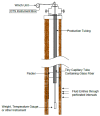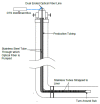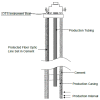Optical Fibre-Based Sensors for Oil and Gas Applications
- PMID: 34577252
- PMCID: PMC8473273
- DOI: 10.3390/s21186047
Optical Fibre-Based Sensors for Oil and Gas Applications
Abstract
Oil and gas (O&G) explorations moving into deeper zones for enhanced oil and gas recovery are causing serious safety concerns across the world. The sensing of critical multiple parameters like high pressure, high temperature (HPHT), chemicals, etc., are required at longer distances in real-time. Traditional electrical sensors operate less effectively under these extreme environmental conditions and are susceptible to electromagnetic interference (EMI). Hence, there is a growing demand for improved sensors with enhanced measurement capabilities and also sensors that generates reliable data for enhanced oil and gas production. In addition to enhanced oil and gas recovery, the sensing technology should also be capable of monitoring the well bore integrity and safety. The sensing requirements of the O&G industry for improved sensing in deeper zones include increased transmission length, improved spatial coverage and integration of multiple sensors with multimodal sensing capability. This imposes problems like signal attenuation, crosstalks and cross sensitivities. Optical fibre-based sensors are expected to provide superior sensing capabilities compared to electrical sensors. This review paper covers a detailed review of different fibre-optic sensing technologies to identify a feasible sensing solution for the O&G industry.
Keywords: oil and gas; optical fibre; sensor.
Conflict of interest statement
No conflict of interest.
Figures























Similar articles
-
A Review: Application and Implementation of Optic Fibre Sensors for Gas Detection.Sensors (Basel). 2021 Oct 12;21(20):6755. doi: 10.3390/s21206755. Sensors (Basel). 2021. PMID: 34695970 Free PMC article. Review.
-
Pultruded FRP Beams with Embedded Fibre Bragg Grating Optical Sensors for Strain Measurement and Failure Detection.Sensors (Basel). 2021 Oct 22;21(21):7019. doi: 10.3390/s21217019. Sensors (Basel). 2021. PMID: 34770325 Free PMC article.
-
Plasmonic nanocomposite thin film enabled fiber optic sensors for simultaneous gas and temperature sensing at extreme temperatures.Nanoscale. 2013 Oct 7;5(19):9030-9. doi: 10.1039/c3nr02891g. Epub 2013 Aug 16. Nanoscale. 2013. PMID: 23948985
-
Liquid Flow Meter by Fiber-Optic Sensing of Heat Propagation.Sensors (Basel). 2021 Jan 7;21(2):355. doi: 10.3390/s21020355. Sensors (Basel). 2021. PMID: 33430229 Free PMC article.
-
Optical Fiber Sensors and Sensing Networks: Overview of the Main Principles and Applications.Sensors (Basel). 2022 Oct 5;22(19):7554. doi: 10.3390/s22197554. Sensors (Basel). 2022. PMID: 36236653 Free PMC article. Review.
Cited by
-
Supervised Deep Learning for Detecting and Locating Passive Seismic Events Recorded with DAS: A Case Study.Sensors (Basel). 2024 Oct 30;24(21):6978. doi: 10.3390/s24216978. Sensors (Basel). 2024. PMID: 39517875 Free PMC article.
-
A Methodology for In-Well Multiphase Flow Measurement with Strategically Positioned Local and/or Distributed Acoustic Sensors.Sensors (Basel). 2023 Jun 27;23(13):5969. doi: 10.3390/s23135969. Sensors (Basel). 2023. PMID: 37447817 Free PMC article.
-
Unveiling the revolutionary role of nanoparticles in the oil and gas field: Unleashing new avenues for enhanced efficiency and productivity.Heliyon. 2024 Jul 2;10(13):e33957. doi: 10.1016/j.heliyon.2024.e33957. eCollection 2024 Jul 15. Heliyon. 2024. PMID: 39055810 Free PMC article. Review.
-
Decoupling of Mechanical and Thermal Signals in OFDR Measurements with Integrated Fibres Based on Fibre Core Doping.Sensors (Basel). 2025 Feb 15;25(4):1187. doi: 10.3390/s25041187. Sensors (Basel). 2025. PMID: 40006416 Free PMC article.
-
Application of Dual-Frequency Self-Injection Locked DFB Laser for Brillouin Optical Time Domain Analysis.Sensors (Basel). 2021 Oct 15;21(20):6859. doi: 10.3390/s21206859. Sensors (Basel). 2021. PMID: 34696075 Free PMC article.
References
-
- Lehmkoster J. World Ocean Review. Maribus gGmbH; Hamburg, Germany: 2014. Schroder, T. Oil and gas from the sea.
-
- Algeroy J., Lovell J., Tirado G., Meyyappan R., Brown G., Greenaway R., Carney M., Meyer J.H., Davies J.E., Pinzon I.D. Permanent monitoring: Taking it to the reservoir. Oilfield Rev. Spring. 2010;22:34–41.
-
- Zhang Y., Xiao L., Fu J., Chen H., Zhao X. The perspective of the permanent monitoring with an FBG sensor network in oil and gas production in China. Int. Soc. Opt. Photonics. 2005;6041:60410X. doi: 10.1117/12.664311. - DOI
-
- Xu X.-H., Peng G., Liu X.-F., Shao Y.-L., Xiao-Hong X., Gang P., Xue-Feng L., Yan-Lin S. Oil and gas exploration information integration management plan based on GIS technology; Proceedings of the 2012 Fourth International Conference on Computational and Information Sciences; Chongqing, China. 17–19 August 2012; pp. 526–529. - DOI
-
- Akhondi M.R., Talevski A., Carlsen S., Petersen S. Applications of wireless sensor networks in the oil, gas and resources industries. Adv. Inf. Netw. Appl. 2010:941–948.
Publication types
MeSH terms
LinkOut - more resources
Full Text Sources

